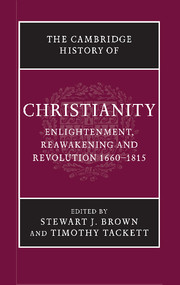Book contents
- Frontmatter
- Introduction
- PART I CHURCH, STATE, AND SOCIETY IN THE EUROPEAN WORLD, 1660–1780
- PART II CHRISTIAN LIFE IN THE EUROPEAN WORLD, 1660–1780
- PART III MOVEMENTS AND CHALLENGES
- 13 Christianity and the rise of science, 1660–1815
- 14 The Enlightenment critique of Christianity
- 15 The Christian Enlightenment
- 16 Jansenism and the international suppression of the Jesuits
- 17 Evangelical awakenings in the North Atlantic world
- 18 Toleration and movements of Christian reunion, 1660–1789
- PART IV CHRISTIAN DEVELOPMENTS IN THE NON-EUROPEAN WORLD
- PART V REVOLUTION AND THE CHRISTIAN WORLD
- Chronology
- Bibliography
- Index
- References
17 - Evangelical awakenings in the North Atlantic world
from PART III - MOVEMENTS AND CHALLENGES
Published online by Cambridge University Press: 28 March 2008
- Frontmatter
- Introduction
- PART I CHURCH, STATE, AND SOCIETY IN THE EUROPEAN WORLD, 1660–1780
- PART II CHRISTIAN LIFE IN THE EUROPEAN WORLD, 1660–1780
- PART III MOVEMENTS AND CHALLENGES
- 13 Christianity and the rise of science, 1660–1815
- 14 The Enlightenment critique of Christianity
- 15 The Christian Enlightenment
- 16 Jansenism and the international suppression of the Jesuits
- 17 Evangelical awakenings in the North Atlantic world
- 18 Toleration and movements of Christian reunion, 1660–1789
- PART IV CHRISTIAN DEVELOPMENTS IN THE NON-EUROPEAN WORLD
- PART V REVOLUTION AND THE CHRISTIAN WORLD
- Chronology
- Bibliography
- Index
- References
Summary
The first great Protestant awakenings arose from an interweaving of Pietism, revivalism, and politics. Revivalism was distinct from Pietism but political circumstances ensured that it never had an entirely independent history. Pietism in the narrow sense of the word was a party (there were others) born of the continent-wide movement for piety early in the seventeenth century, but taking its peculiar shape from its creation within an atmosphere of conflict with Lutheran Orthodoxy; the Pietist party was Phillip Jacob Spener’s answer to the disappointment of his hopes of achieving a consensus for renewal and reform. It was an answer to the problems of religious establishments in the doldrums. Revival began among the vast number of Protestants in the triangle between Transylvania, Poland and Salzburg, those who had been abandoned and left with little defence by the peace settlements of Westphalia, and hence those who (outside Hungary) had no church system to renew. The experience of these abandoned Protestants shaped the whole history of revivalism. The original compulsion among the Protestant minorities to get results quickly ensured that there was always an ethos of desperation about revivalism. Because, for these Protestant minorities, the old ways were not normative and mostly not available, they had both freedom and compulsion to experiment. Not that old ideas were of no account, for, like Pietism, revivalism grew out of the Lutheran Orthodox tradition. The revivalist theory that at the bottom of everyone’s mind and conscience were fragments of belief which could be revived and made effective reflected the experience of the Protestant minorities in Silesia and the Habsburg lands long before the theory was formulated.
- Type
- Chapter
- Information
- The Cambridge History of Christianity , pp. 329 - 347Publisher: Cambridge University PressPrint publication year: 2006



